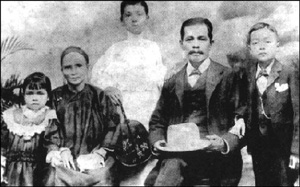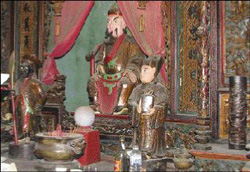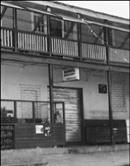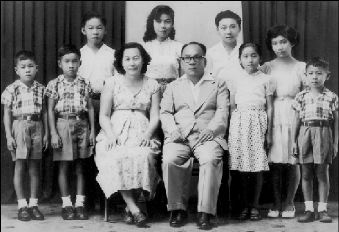|
Out
Of Many Cultures The People Who Came
The Arrival
Of The Chinese
 |
Courtesy
of the Patrick Lee
Mr. William Chin Len Kow and his family, one of the pioneer settlers,
arrived in Jamaica in 1895. He is one of the three people who
bought the Chinese cemetery for the community in 1901 and was
a founding father of Chee Kung Tong.
|
By
Dr. Rebecca Tortello
THE
BEGINNINGS
The story of
the Chinese in Jamaica is linked to Panama and railways. In the mid-19th
century, many Chinese looked west: to California, answering the call of
the gold rush, and to Panama, where labourers were required for the building
of a railroad from Panama City to Colon. Both options promised improvement
in their lives and those of their children and led many Chinese to break
the law and leave China prior to 1891, the year the Chinese Government
officially allowed emigration. The
first large group of 267 Chinese immigrants came from Hong Kong on July
30, 1854, just months before those from Panama, on a ship called Epsom.
They were destined for indentureship. Later that year, 205 Chinese workers
demanded to leave Panama fearing yellow fever. They arrived in Jamaica
on November 1 and 18, on ships called the Vampire (195 people)
and the Theresa Jane (10 people) respectively. Panamanian authorities
sent them to nearby Jamaica solely due to its proximity and in exchange
for Jamaican labourers. Many were already ill on arrival and were sent
to hospital in Kingston where they eventually died. Less than 50 immigrants
survived. Of these, one, Robert Jackson Chin (Chin Pa-kung), opened a
wholesale house on downtown Kingston's Pechon Street (where the Desnoes
and Geddes building now stands). In doing so he unknowingly paved the
way for many of his countrymen. Two others, Chang Si-Pah and Lyn Sam opened
grocery stores nearby. All three men provided guidance to successive batches
of immigrants.
 |
The
Altar with the god, Kuang Gung, on the third floor of the original
Chinese Benevolent Association building on Barry Street, Kingston.
In the past, on Chinese New Year people would go there to pray
for good fortune. Courtesy
of the Patrick Lee. Taken by Mr Lee, 2002.
|
INDENTURESHIPS
AND THE RISE OF THE CHINESE GROCERY
A decade
later in the 1860s another set of Chinese arrived from Trinidad and British
Guiana. There they had worked as indentured labourers in the canefields
until hurricane and insects threatened their job security. Some 200 Chinese
workers answered a call for three-year contract labourers in Jamaica to
tend to the American-led large scale planting of coconuts, bananas and
sugar. When their three-year contracts were up, some continued in the
fields even though they were not welcomed with open arms by the
newly emancipated slaves
who saw them as competition. Others started small shops of their own where
total weekly sales tended to amount to less than £8 on average. By
this time, Chinese grocers were becoming known for extending credit to
favoured customers, selling by barter, providing round-the-clock service
and selling goods in small, affordable quantities. It is as a result of
their importation activities that items such as rice, saltfish, saltmeats,
flour and cornmeal became staples of the Jamaican diet.
A
COMMUNITY GROWS
In the 1860s, a close-knit
Jamaican-Chinese community began to emerge with many living above, behind
or somewhere near to their shops. Downtown, a retail area became known
as Chinatown. Two decades later, in the 1880s, another group of 680 immigrants
arrived this time directly from China. They had been recruited
as farm labourers. There were 501 men, 105 women, 54 boys and 17 girls
who docked in Kingston Harbour in 1884 after having survived a typhoon
aboard the 67 day voyage. Upon arrival, they were claimed by the plantation
owners who held their contracts and scattered across the island. Among
this group was Chin Tung-Kao, who in 1891 would found the Chinese Benevolent
Society to offer humanitarian and social aid as well as protect Chinese
customs and preserve their ethnic identity, at 131 Barry Street in downtown
Kingston.
Following 1885 large-scale
immigration of Chinese labourers occurred in an attempt to satisfy the
demand for field labour created by the departure of African-Jamaican and
East Indian labourers from the plantations. This fourth wave of immigrants
totalled close to 700. Some came without contracts and were thus able
to choose their occupation, which was generally divided between farming
and the retail grocery trade. These immigrants, like many of those who
had come before, were not generally well-received by Jamaicans, and so
they tended to stick together. There were continual racial slurs, some
were held in Spanish town on arrival under armed guard until they were
shipped out in mule carts to the various plantations.
FACING
CHALLENGES
 |
Built
between 1948-51, this building was typical of the Chinese, with
business downstairs and home upstairs. Mr. Samuel Kong established
his business in 1937 after arriving in Jamaica in 1920. He moved
his business into this building in Richmond, St. Mary, in 1951.
Here, Mr. Kong sold gasoline for autos and kerosene oil in the
front; and grocery, hardware, haberdashery, furniture, pimento
and cocoa inside. There was also a bakery to the back. Both businesses
are still in operation today.
Photo taken in 1970's. Courtesy of the Kong family.
|
In 1888, more than
800 additional Chinese arrived and the Jamaican business community began
to get nervous. Fearful that they would lose control of the retail grocery
trade, they lobbied the Jamaican Government to impose the first in a set
of immigration laws that would make it more difficult for Chinese immigrants
to come to the island. The new restrictions went into effect in 1905.
Immigrants were now required to register with the authorities and provide
a guarantee from a reliable person as to the soundness of their characters.
In 1910, new and even harsher conditions were added. Chinese immigrants
arriving subsequent to that date had to pay a £30 deposit upon landing
and also pass a physical and a test showing that they could write and
speak 50 words in 3 different languages. This law made it more difficult
but not impossible for already settled Chinese-Jamaicans to send for their
relatives.
By the mid-1920s the
total number of Chinese who emigrated to Jamaica numbered close to 4,000.
By 1930, an additional 2,000 Chinese had arrived. In 1931, however, the
Jamaican Govern-ment issued a decree that no passport was to be issued
to Chinese coming to Jamaica excepting to those under 14 years old who
were allowed student permits. This was largely a result of ill-will towards
the Chinese who had by this time branched out into laundries, restaurants
and bakeries in addition to retail groceries. They were doing well on
the island, contributing to national development while providing for the
families. In the 1930s, during the labour riots, not surprisingly, many
Chinese groceries were looted and robbed, and in some cases, their owners
murdered. This decree stood until 1947 when the Chinese consulate (established
in the 1920s and largely supported by the Jamaican-Chinese community)
in Kingston succeeded in persuading the Jamaican Government to relax these
restrictions, remove the quota system that had been placed on wives and
children and parents and allow Chinese immigrants to send for their family
members.
THE
JAMAICAN-CHINESE
 |
1953,
Mr. Samuel Kong with his wife, Wong Fong Yin, and their eight
children. Courtesy
of the Kong family.
|
By this time, in the
1940s, many of the second-generation, those who were truly Jamaican-Chinese,
began to rebel against their parents' desires to remain wedded to Chinese
culture. They left the family business, went into other professions and
embraced aspects of Jamaican culture. Many also converted to Roman Catholicism.
Resentment from African-Jamaicans waned as tolerance of aspects of Chinese
culture grew and some amalgamations occurred. One of the most notable
examples is the numbers game "drop pan." Drop Pan in Cantonese "Jih Fah"
and Hakka "Sue Fah," is named for the fact that tickets numbered 1 to
36 are dropped in a pan to see who wins. Many players play based on dreams
and portents, although some play by odds based on a study of the pattern
of play. Drop Pan is said to have arrived in Jamaica with the earliest
Chinese immigrants in the 1850s. It was restricted by the government as
early as 1898. This law was amended in the 1920s due to the game's substantial
popularity. Today, drop pan's meanings are most likely both Chinese and
Afro-Jamaican in origin. According to Barry Chevannes in a Jamaica
Journal article on Drop Pan, "the number 7 means married woman and
hog. In Chinese custom a son-in-law makes a gift of a pig or pork to his
mother-in-law every New Year. The number 11 means baby boy and dog. Among
the Chinese, the dog is a blessing as are newborn males" (p. 46). The
number 8 stands for belly, belly (pregnant) woman, hole or ring, all of
which could be related to Rastafarian belief that "a woman has no lineage.
A woman is only a vessel" (p. 47).
Despite some "Jamaicanization,"
the Chinese have also worked hard to maintain links to their culture.
Writers like Anglican priest Easton Lee, explore their Chinese Jamaican
roots in poetry and prose. Restaurants continue to offer Dim Sum, the
traditional Chinese Sunday brunch, and many supermarkets sell traditional
Chinese cooking ingredients. The Chinese Benevolent Society has 5 subsidiary
organizations: the Chinese Public School, the Chinese Sanitariam, the
Chinese Alms House, the Chinese Public News and the Chinese cemetery on
Heart's East Ashley Road. The Miss Jamaica Chinese Beauty Pagaent is no
longer held, but many Jamaican beauties of Chinese descent have entered
and done well in the Miss Jamaica beauty contests. Winners include Sheila
Chung and Patsy Yuen. Chinese holidays such as Chinese New Year, and the
Moon and Boat Festivals as well as the anniversary of the Founding of
the People's Republic of China, are still celebrated in style if less
extravagantly than earlier in the 20th century when they often included
dinners and fireworks.
Chinese Jamaicans
have also made their mark in the political arena with MPs such as Rose
Leon, Ferdinand Yap-Sam and Delroy Chuck. Similarly, Chinese Jamaican
impact on the business world is far reaching with families and individuals
controlling substantial restaurant, bakery and supermarket chains such
as Island Grille, Purity and SuperPlus, as well as banks such as NCB.
Next year, to celebrate
the 150th anniversary of The Chinese arrival in Jamaica, Patrick Lee is
publishing his new book "Jamaican Chinese Worldwide - One Family"
which will include families from Jamaica, USA, Canada and Britain.
|
| Feedback To the Series |
|
"This is
an absolutely fantastic series. It is critical that we preserve these
for the long term as well as continuing to share with upcoming generations
so that they can understand and feel connected to the past and that it
continues to have some relevance to their future." - Peter,
USA.
"This article
was heartfelt. I moved away from my home country, Jamaica, as a little
girl and have missed out on some of the history that I was to have learned"
- Cadiehead, Jamaica.
"My son is
now learning a great deal about the history of his parents homeland. Please
continue with this fantastic educational site." - Sonia ,
England.
"Keep up the
good works. It's important that these events and people are chronicled,
so that history doesn't die, or get misinterpeted. Remember no history,
no future." - Fabian, Canada.
"Touching,
touching I yet again applaud at how much exposed Jamaica is. Keep writing
these articles they are they main reason I read the newsletters (Go-jamaica)."
- Georgia, USA
"Thoses Proverbs
are great. I remember growing in Jamaica and hearing my grandmother using
some of them." - Richard, Puerto Rico.
"I think
these proverbs are very, very good especially for me who always like my
roots and culture so much. Indeed I appreciate things of like this that
not only educate but keeps one in line with their past. Once again thank
to you all for this great effort. Now I know where to procure educative
information. I am really impressed. Go my Jamaica. " - Motumbo,
Costa Rica
|
| The
First 500 years in Jamaica |
|
We're
taking you for a stroll down memory lane for the next six
months. Along this journey,we will relive several events which
significantly impacted on the social, political and economic
development of Jamaica. As we travel share your experience
with us...
Send your comments to:
Pieces
of the Past,
The Gleaner Company Ltd.,
7 North Street, Kingston;
E - mail us: editor@gleanerjm.com
Fax 922-6223.
|
|
|



